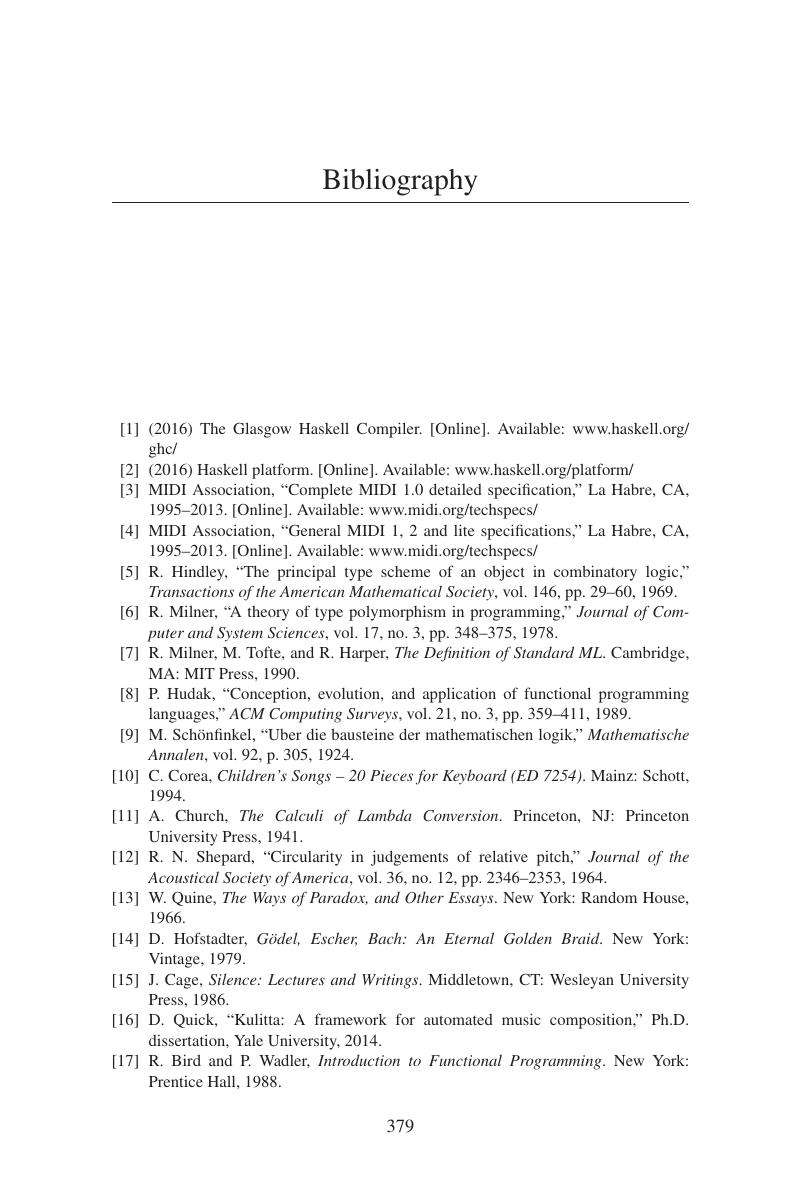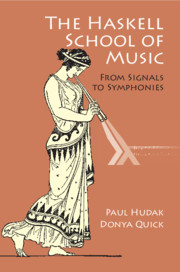Book contents
- Frontmatter
- Contents
- Preface
- Acknowledgments
- 1 Computer Music, Euterpea, and Haskell
- 2 Simple Music
- 3 Polymorphic and Higher-Order Functions
- 4 A Musical Interlude
- 5 Syntactic Magic
- 6 More Music
- 7 Qualified Types and Type Classes
- 8 From Music to MIDI
- 9 Interpretation and Performance
- 10 Self-Similar Music
- 11 Proof by Induction
- 12 An Algebra of Music
- 13 L-Systems and Generative Grammars
- 14 Random Numbers, Probability Distributions, and Markov Chains
- 15 Basic Input/Output
- 16 Higher-Order Types and Monads
- 17 Musical User Interfaces
- 18 Sound and Signals
- 19 Euterpea’s Signal Functions
- 20 Spectrum Analysis
- 21 Additive and Subtractive Synthesis
- 22 Amplitude and Frequency Modulation
- 23 Physical Modeling
- Appendix A The PreludeList Module
- Appendix B Haskell’s Standard Type Classes
- Appendix C Built-In Types Are Not Special
- Appendix D Pattern-Matching Details
- Appendix E Haskell Quick Reference
- Appendix F Euterpea Quick Reference
- Appendix G HSoM Quick Reference
- Bibliography
- Index
- References
Bibliography
Published online by Cambridge University Press: 21 September 2018
- Frontmatter
- Contents
- Preface
- Acknowledgments
- 1 Computer Music, Euterpea, and Haskell
- 2 Simple Music
- 3 Polymorphic and Higher-Order Functions
- 4 A Musical Interlude
- 5 Syntactic Magic
- 6 More Music
- 7 Qualified Types and Type Classes
- 8 From Music to MIDI
- 9 Interpretation and Performance
- 10 Self-Similar Music
- 11 Proof by Induction
- 12 An Algebra of Music
- 13 L-Systems and Generative Grammars
- 14 Random Numbers, Probability Distributions, and Markov Chains
- 15 Basic Input/Output
- 16 Higher-Order Types and Monads
- 17 Musical User Interfaces
- 18 Sound and Signals
- 19 Euterpea’s Signal Functions
- 20 Spectrum Analysis
- 21 Additive and Subtractive Synthesis
- 22 Amplitude and Frequency Modulation
- 23 Physical Modeling
- Appendix A The PreludeList Module
- Appendix B Haskell’s Standard Type Classes
- Appendix C Built-In Types Are Not Special
- Appendix D Pattern-Matching Details
- Appendix E Haskell Quick Reference
- Appendix F Euterpea Quick Reference
- Appendix G HSoM Quick Reference
- Bibliography
- Index
- References
Summary

- Type
- Chapter
- Information
- The Haskell School of MusicFrom Signals to Symphonies, pp. 379 - 380Publisher: Cambridge University PressPrint publication year: 2018



